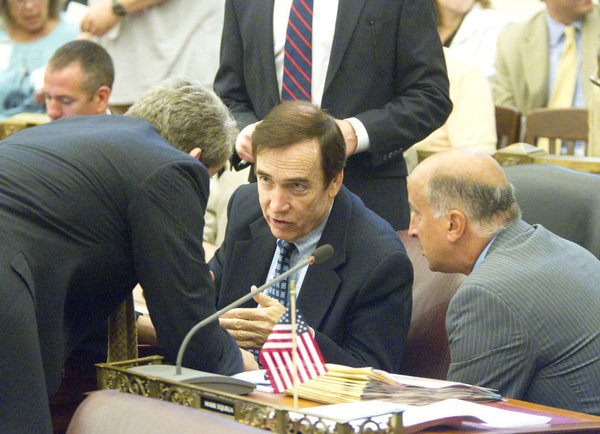O’Neill bills reclassify uses in commercial mixed-use districts, create new district to be mapped in

Hold onto your hats, planning fans. Things are about to get weird.
During the zoning reform process, the Zoning Code Commission created a series of districts labeled CMX, for Commercial Mixed Use. Each such district is followed by a number which indicates its relative density: CMX-1 being the sparsest, and CMX-5, intended almost solely for Center City, being the densest.
The CMX-2 district is “primarily intended to accommodate neighborhood-serving retail and service uses,” according to the code. The CMX-2.5 district is “primarily intended to accommodate active, pedestrian-friendly retail and service uses in commercial nodes and along commercial corridors. The range of allowed uses is slightly narrower than the CMX-2 district and the development standards are intended to promote a pedestrian-oriented environment.”
A bill introduced Thursday morning by Councilman Brian O’Neill makes both the CMX-2 and CMX-2.5 districts more restrictive. It makes prepared food stores and artist studios from permitted uses into special exceptions, and prohibits visitor accommodations and animal services, to name a few.
In a two-part Rules Committee hearing over the past two weeks, the Planning Commission successfully objected to having 21 use categories in the CMX-2 district changed in the zoning code clean-up bill it drafted.
The amendments had been proposed by O’Neill, who later agreed to introduce them in a separate bill, which he did Thursday morning. At the same time, O’Neill introduced another bill which would create a new zoning district he’s calling CMX-2.2. That district is a copy of the CMX-2 district in the code currently; O’Neill says it would have to be mapped into individual neighborhoods and adopted by ordinance.
If O’Neill’s bills are adopted by the whole Council, the uses currently allowed by right in CMX-2 districts, which include a number of neighborhood commercial corridors, would decrease; O’Neill’s changes make fifteen uses (down from 21) currently allowed by right into prohibited or Special Exception uses. At the same time, the standards of the CMX-2 district will live on in CMX-2.2, but will need to be mapped into individual areas specifically.
If that sounds confusing, think of it this way: the bills would essentially rezone all CMX-2 districts in the city into something like the C-2 district of the old code; the standards of CMX-2 would then cease to exist until mapped in, as CMX-2.2, neighborhood by neighborhood. The permission changes made to CMX-2 in his bill also apply to CMX-2.5 districts.
OK, that still sounds confusing. Sorry. It just is.[i]
O’Neill described a zoning case in his district recently in which a property owner had, under the old code, proposed a certain use of a property now zoned CMX-2. The use—O’Neill didn’t specify what it was—was not allowed by right in the old code, and some neighbors went to the zoning board meeting and said they wanted to meet with the owner. They didn’t oppose the project, according to O’Neill, they just wanted to discuss it. But the owner balked and said he could re-apply for his permit under the new code and bypass the zoning board and the community altogether.
That got O’Neill thinking that the more permissive CMX-2 district may be good for some commercial corridors closer to Center City, but that the old code felt more appropriate for his Northeast district. Hence his bills.
Eva Gladstein, deputy director of the Planning Commission, pointed out that none of these changes were proposed when Council made recommendations for the Zoning Code Commission’s final report last fall, and Councilman O’Neill confirmed the issue wasn’t important to him at that time.
“I wasn’t carrying this from [the zoning reform debate],” O’Neill said. “It only came up just recently.”
O’Neill said he is trying to resolve the perennial problem of Northeast Philadelphia’s unmistakable distinctness in the city generally. He was active on the Zoning Code Commission in trying to make sure that distinctness was accounted for in the citywide zoning standards, and now is trying to do the same in his role as District Councilmember.
But Gladstein said his method for doing so functionally “puts the burden” for mapping CMX-2.2 back into neighborhoods onto every other District Councilmember.
“The kind of rollback to the old zoning code and then requiring people to have to remap to CMX-2.2, does not seem like a reasonable action to us,” Gladstein said.
Contact the reporter at jaredbrey@gmail.com and follow him on Twitter @jaredbrey
[i] (O’Neill also said his first set of amendments would have unintentionally changed the CMX-2 district into the miniscule and restrictive RC-2 district of the old code; he’d meant to roll it back to the more common C-2 district instead.)
WHYY is your source for fact-based, in-depth journalism and information. As a nonprofit organization, we rely on financial support from readers like you. Please give today.



